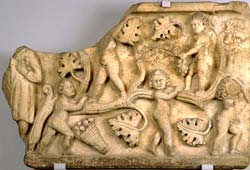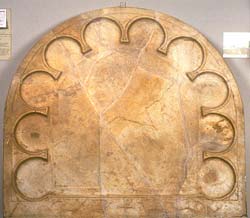 |
 |
 |
| Lecture 3. Late Antiquity West: |
|
Using the death and subsequent cult of Saint Peter the Apostle as a node of study, we will examine the rise of Christianity in the Roman world, and the way that art and architecture reflects the changing circumstances of the period. Fundamental to this examination will be an understanding of the ways that the art of the early Christian period was traditional in its dependence upon Late Antique visual culture yet remarkably new. From its inception the art of Christians relied upon the sophisticated visual language of the Roman world, utilizing systems of narrative and symbolism firmly entrenched in Mediterranean Hellenism. Perhaps this was out of necessity, as the doctrine of the Christian religion purposefully subverted the pantheon of the Ancient world and in doing so, Christians became targets of Imperial persecution. They rendered their art, specifically their funerary art less conspicuous by utilizing conventional or at least familiar imagery, highly symbolic in nature. However, another way of understanding this phenomenon of the consonance of Christian and other images is to recognize the subtle waves of conversion: Christians converted to a new religion that was vastly different not only from Ancient non-Christian practice but also quite different from the Christianity practiced in the years 800, 1200, and 2000, so the ways of proclaiming difference may not be in accord with what we might imagine. Further the changes in visual culture of the Roman Empire occurred across the board, and transformed cultic imagery not only of Christians, but of followers of Jupiter, Isis, Mithras, and Yahweh alike. The story of Peter and his martyrdom, and the sequence of monuments marking his death provide a particularly illustrative example of the symbiosis of religious practice in the Late Antique world, and the conscientious use of ancient Roman traditions of art and architecture to articulate an essentially new meaning. We will explore the artistic and architectural manifestations and implications of Christ's statement to Peter: Et ego dico tibi, quia tu es Petrus, et super hanc petram aedificabo ecclesiam meum, et portae inferi non praevalebunt adverus eam. Et tibi dabo claves regni caeolorum. "And I say to thee: That thou art Peter; and upon this rock I will build my church, and the gates of hell shall not prevail against it. And I will give to thee the keys of the kingdom of heaven." Matthew 16:18-19. |



